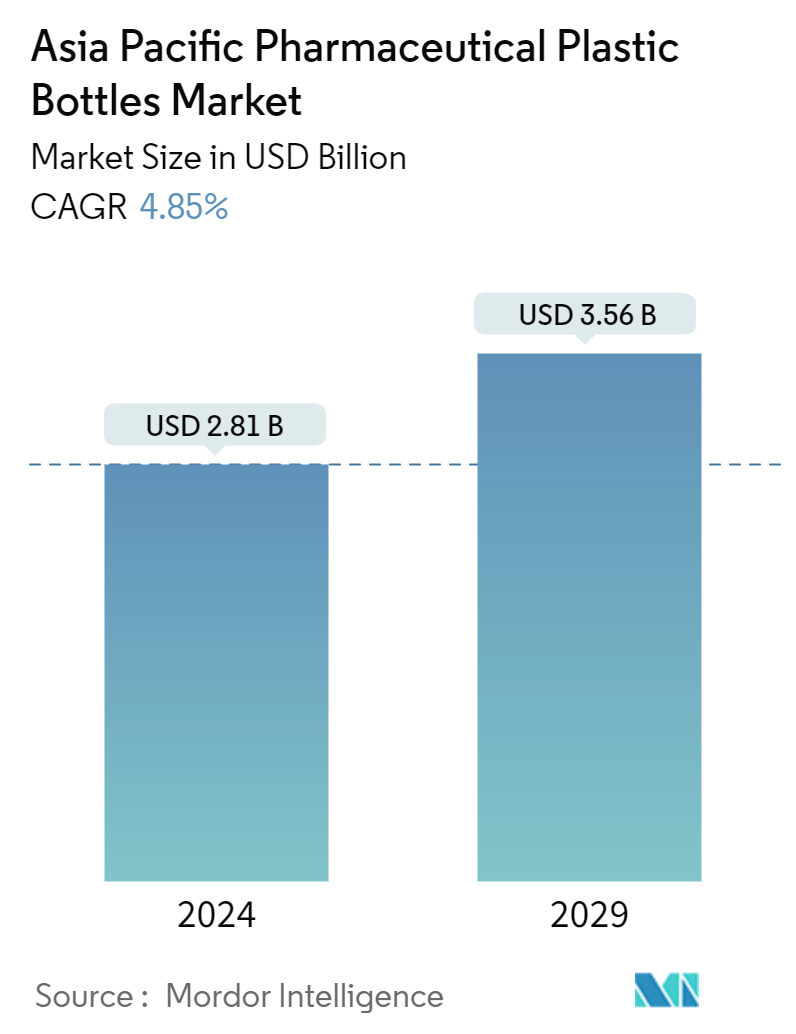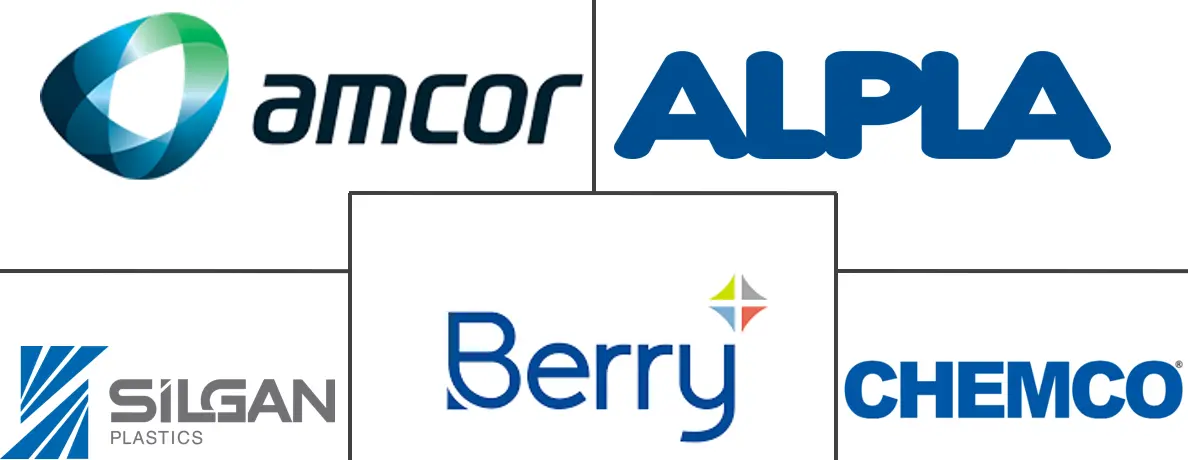Market Size of Asia-Pacific Pharmaceutical Plastic Bottles Industry

| Study Period | 2019 - 2029 |
| Base Year For Estimation | 2023 |
| Market Size (2024) | USD 2.81 Billion |
| Market Size (2029) | USD 3.56 Billion |
| CAGR (2024 - 2029) | 4.85 % |
| Market Concentration | Low |
Major Players
*Disclaimer: Major Players sorted in no particular order |
Asia-Pacific Pharmaceutical Plastic Bottles Market Analysis
The Asia Pacific Pharmaceutical Plastic Bottles Market size is estimated at USD 2.81 billion in 2024, and is expected to reach USD 3.56 billion by 2029, growing at a CAGR of 4.85% during the forecast period (2024-2029).
- China's policies to expedite the transformation of its medical regime are anticipated to contribute to the growth of the market for pharmaceutical plastic bottles. Additionally, China is modernizing its pharmaceutical packaging infrastructure and materials and expanding its pharmaceutical plastic bottle range, likely opening up new prospects for pharmaceutical packaging companies. For instance, the Government of China intends to develop a 10-year strategic plan to become a world leader in several high-tech sectors.
- Further, these sectors unexpectedly include biotech, which is not traditionally a vital area of Chinese manufacturing, being more associated with generic production. The government has significantly increased its investments in and promoting biotech to encourage innovation. Currently, biologically advanced output, including cell and gene therapy, is limited in Eastern China, focusing on the US FDA-approved sites in the provinces of Shanghai, Zhejiang, and Jiangsu.
- India is the most populous nation, with 1.4 billion inhabitants and the fifth-largest economy. Due to the well-established pharmaceutical industry, rising investments in the sector, the expanding population, increasing health awareness, and rising life expectancy, the market for plastic bottles for pharmaceutical packaging solutions in India is anticipated to grow significantly.
- The government has imposed stringent rules for using plastic bottles in pharmaceutical packaging. This may be a significant constraint for some time. It has a negative effect on the profit margins of the producers. However, the raw materials used for biodegradability are costly compared to non-biodegradability, increasing the overall production cost. Therefore, increasing cost pressures will also hold back the market growth.
Asia-Pacific Pharmaceutical Plastic Bottles Industry Segmentation
Pharmaceutical plastic bottles are containers specifically designed and manufactured for the storage and distribution of pharmaceutical products. These bottles are an essential component of the pharmaceutical packaging industry and play a crucial role in maintaining the safety, efficacy, and integrity of medications and other healthcare products.
The Asia-Pacific pharmaceutical plastic bottles market is segmented by raw material (polyethylene terephthalate (PET), polypropylene (PP), low-density polyethylene (LDPE), high-density polyethylene (HDPE)), type (dropper bottles, nasal spray bottles, liquid bottles, oral care, other types), and country (China, India, Japan, Australia and New Zealand, and Rest of Asia-Pacific). The market sizes and forecasts are provided in terms of value (USD) for all the above segments.
| By Raw Material | |
| Polyethylene Terephthalate (PET) | |
| Polypropylene (PP) | |
| Low-density Polyethylene (LDPE) | |
| High-density Polyethylene (HDPE) |
| By Type | |
| Dropper Bottles | |
| Nasal Spray Bottles | |
| Liquid Bottles | |
| Oral Care | |
| Other Types |
| By Country*** | |
| China | |
| India | |
| Japan | |
| Australia and New Zealand |
Asia-Pacific Pharmaceutical Plastic Bottles Market Size Summary
The Asia-Pacific pharmaceutical plastic bottles market is poised for significant growth, driven by advancements in the pharmaceutical sectors of countries like China and India. China's strategic initiatives to modernize its pharmaceutical packaging infrastructure and expand its range of plastic bottles are expected to open new opportunities for packaging companies. The government's focus on becoming a leader in high-tech sectors, including biotech, is likely to spur innovation and demand for advanced packaging solutions. Similarly, India's burgeoning population, coupled with a well-established pharmaceutical industry and increasing health awareness, is anticipated to fuel the demand for plastic bottles in pharmaceutical packaging. However, stringent regulations on plastic use and the high cost of biodegradable materials may pose challenges to market growth.
The market is characterized by a shift from traditional glass bottles to PET plastic bottles, which offer advantages such as reduced weight and cost-effective transportation. PET's versatility in design and its safety features make it a preferred choice among manufacturers. The availability of plastic products in the region supports the expansion of the pharmaceutical industry, as companies seek to meet rising demand and explore new markets. The fragmented market landscape sees key players like Amcor Group, Silgan Holdings, and Chemco Group engaging in strategic partnerships and acquisitions to strengthen their market positions. Innovations in sustainable packaging, such as the development of bottles from recycled materials, are also contributing to the market's growth trajectory.
Asia-Pacific Pharmaceutical Plastic Bottles Market Size - Table of Contents
-
1. MARKET INSIGHTS
-
1.1 Market Overview
-
1.2 Industry Attractiveness - Porter's Five Forces Analysis
-
1.2.1 Threat of New Entrants
-
1.2.2 Bargaining Power of Buyer
-
1.2.3 Bargaining Power of Suppliers
-
1.2.4 Threat of Substitute Products
-
1.2.5 Intensity of Competitive Rivalry
-
-
1.3 Industry Value Chain Analysis
-
-
2. MARKET SEGMENTATION
-
2.1 By Raw Material
-
2.1.1 Polyethylene Terephthalate (PET)
-
2.1.2 Polypropylene (PP)
-
2.1.3 Low-density Polyethylene (LDPE)
-
2.1.4 High-density Polyethylene (HDPE)
-
-
2.2 By Type
-
2.2.1 Dropper Bottles
-
2.2.2 Nasal Spray Bottles
-
2.2.3 Liquid Bottles
-
2.2.4 Oral Care
-
2.2.5 Other Types
-
-
2.3 By Country***
-
2.3.1 China
-
2.3.2 India
-
2.3.3 Japan
-
2.3.4 Australia and New Zealand
-
-
Asia-Pacific Pharmaceutical Plastic Bottles Market Size FAQs
How big is the Asia-Pacific Pharmaceutical Plastic Bottles Market?
The Asia-Pacific Pharmaceutical Plastic Bottles Market size is expected to reach USD 2.81 billion in 2024 and grow at a CAGR of 4.85% to reach USD 3.56 billion by 2029.
What is the current Asia-Pacific Pharmaceutical Plastic Bottles Market size?
In 2024, the Asia-Pacific Pharmaceutical Plastic Bottles Market size is expected to reach USD 2.81 billion.

